#joel rifkin
Explore tagged Tumblr posts
Text
When they use that blue ahh shirt 👅👅👅

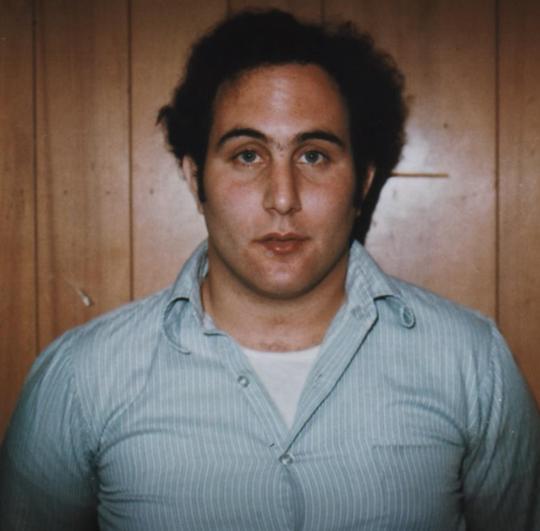
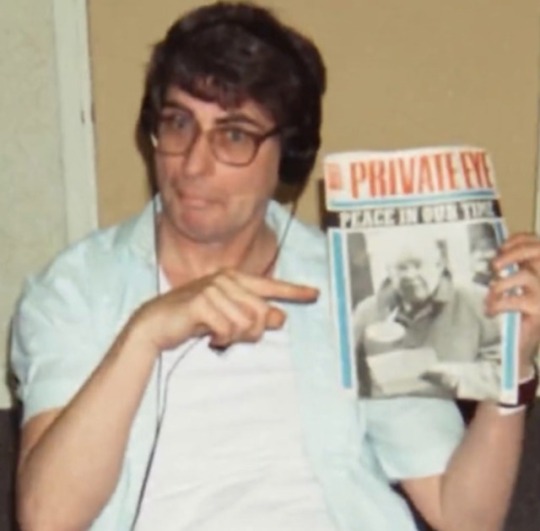


#tcc#tc community#tcc tumblr#tccblr#dennis nilsen#edmund kemper#joel rifkin#son of sam#david berkowitz#idk what else to tag
61 notes
·
View notes
Text
Hi ^_^
This will be the start of a new blog of mine, I already had one before but I decided to start again.
About me!
-im Samuel, but I prefer to be called just "Samu"....
-Im gender fluid, and I'm asexual ^^
-I prefer to keep personal information about myself to a minimum, if you want to know more about me my dms are always open! :D
-I enjoy drawing very, very much!
Interests!
-I'm multi fandom, I'm in too many fandoms!
-I love Star Wars, Literature, Comics, DC, True Crime and mysterious cases mostly, etc!
(btw It may be a bit problematic in some fandoms, and yes, I am a bit problematic but I would never condemn such acts in real life...)
#star wars#literature#ringo starr#darth vader#true cringe community#personal blog#myra hindley#ian brady#dennis nilsen#edmund kemper#joel rifkin#rosemary west
5 notes
·
View notes
Text
Cabaret's Shifting Lead Placement
Welcome to another rambling theatre history lesson with DroughtofApathy. Today we're going to examining the fascinating history of Cabaret's ever-changing lead roles.
Ground rule: Tony eligibility for Lead Actor/Actress is first determined by "above-the-title" billing in the show's opening night Playbill. It was a far stricter guideline in the past, as you'll see. These days, many lead roles aren't put above the title (ex. Hadestown, Kimberly Akimbo, etc.) but will be placed in lead categories either because it's obviously a lead, or because producers lobby for it. Conversely, actors can have "above-the-title" billing and be in featured roles, usually because they're major names like Angela Lansbury and Elaine Stritch, who were both Madame Armfeldt in the 2009/2011 revival of A Little Night Music. In which case, producers will usually submit them as featured.
When Cabaret opened on Broadway in 1966, Jill Haworth (Sally), Jack Gilford (Herr Schultz), and Bert Convey (Cliff) got top billing with Lotte Lenya (Fraulein Schneider) in the coveted "and" slot just below. Note who's missing. That's right. When the show premiered, Joel Grey (Emcee) was just a regular old featured role.
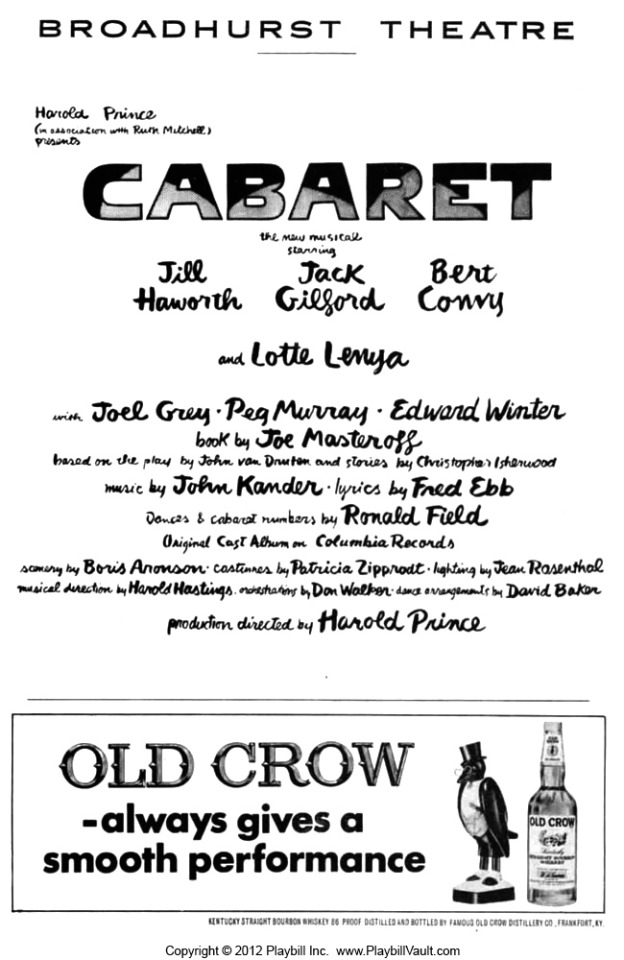

Left: opening night playbill billing. Right: post-Tony rebilling with Joel Grey's ascension.
At the 1967 Tonys, Jack Gilford (Herr Schultz) and Lotte Lenya (Fraulein Schneider) were nominated as Leading Actor/Actress, respectively, while Joel Grey and Edward Winter (Ernst Ludwig) were both in Featured. Jill Haworth (Sally) was not nominated, but would have been eligible for Lead as she had "above-the-title" billing. At the time, Joel Grey was just another working actor. Not so after Cabaret. His performance elevated both the role and his billing, thus transforming the Emcee into a Leading Role from then on.
Subsequent productions would focus more on Sally and the Emcee, while Schultz and Schneider (and the non-singing Cliff) would become featured roles. However, the "above the title" Tony ruling was far stricter back in the day, leading Sally (this time Alyson Reed) to once more be featured in the 1987 revival.


Left: opening night Playbill billing. Right: poster billing
In 1987, Joel Grey was given the sole "above-the-title" billing with Alyson Reed in the next featured spot. Though Sally was, like 1966, technically a lead role, she was nominated in featured at the Tonys that season. (Grey was not eligible as he was reprising his role.) In this production, Regina Resnik (Schneider) and Werner Klemperer (Schultz) both got fancy featured billing and nominations in their respective categories. As Cliff, Gregg Edelman got the "and" billing, but in this case it was less elevated than either Resnik or Klemperer (note the boxes). Edelman was still early-career at this point, and not yet a "name" but Cliff was still considered an elevated role in the company.
By 1998, however, the roles as we currently think of them had finally slotted into place. Alan Cumming (Emcee) won for Best Actor, Natasha Richardson (Sally) for Best Actress and Ron Rifkin (Schultz) for Featured Actor. Mary Louise Wilson (Schneider) was nominated in Featured Actress. Richardson also received left-side billing, as she was a larger name (arguably) than Cumming at the time.
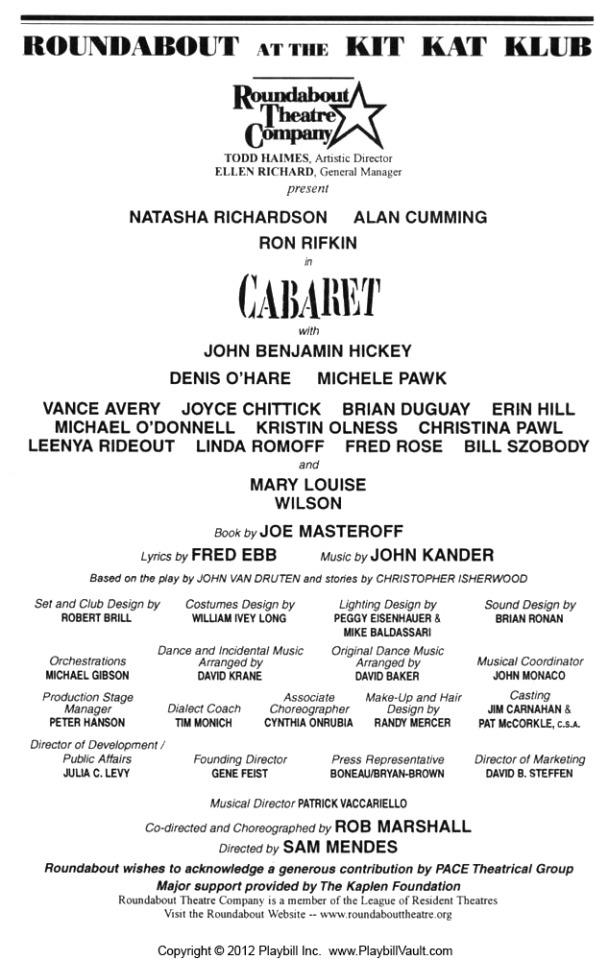
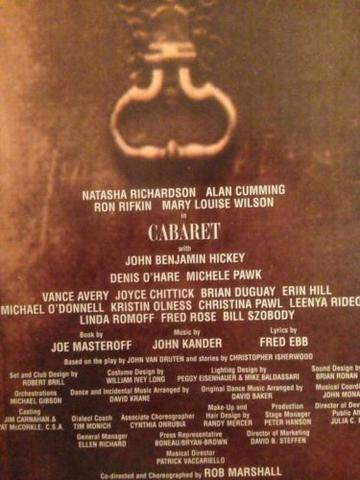
Left: opening night Playbill billing. Right: lobby poster billing
But though nominations seemed to make sense, it still didn't jive with billing placement. In the 1998 production, Richardson, Cumming, and Rifkin all had "above-the-title" with Wilson in the featured "and" slot. Despite this placement, Rifkin went in for Featured. Producers can lobby the Tony committee for actor placement if they think it fitting, and these days we're a lot more fast-and-loose with the definitions. Note however, how Wilson has "above-the-title" billing in the lobby board. This was presumably a contractual renegotiation that happened post-Tonys. Note how Denis O'Hare (Ernst) and Michele Pawk (Kost) have their own line below John Benjamin Hickey (Cliff). All three were/are modest, but known, names in the theatre world, about equal to one another, at least at the time.
By 2014, the old couple (Schultz and Schneider) no longer would get top billing. Alan Cumming only built upon Joel Grey's foundation to fully elevate the Emcee role into the undisputed leading man, with Sally the star-vehicle leading lady. Between the 1998 and up until the recent revival, the older couple's story--and Cliff's importance--had taken a backseat.
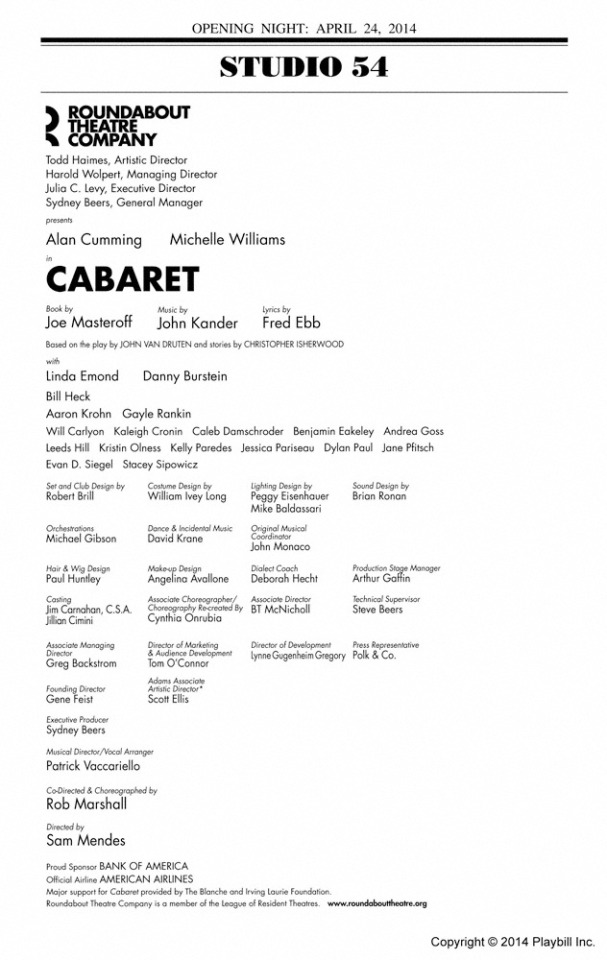

Left: opening night Playbill billing. Right: poster billing.
In 2014, the revival won no Tonys, but was nominated for both Featured Actor and Actress (Danny Burstein and Linda Emond, respectively). Cumming was not eligible as, like Joel Grey before him, he was reprising his role. This time, with a Tony in his pocket, and a much bigger name than 16 years prior, he got left-side billing. Emond and Burstein received equal line billing below the title, with Emond getting the left. Though they were roughly equal in the theatre world, and Burstein had a slight edge in terms of Tony noms, I'd guess Emond got the left owing to her larger screen presence/notoriety. In the poster, Bill Heck (Cliff) is left out of featured billing entirely, as are Aaron Krohn (Ernst) and Gayle Rankin (Kost).
Now we come to our latest revival, number four. Though it's still too early for nominations, we can assume Eddie Redmayne (Emcee) and Gayle Rankin (Sally) will be leads with all others featured. Historically, Schultz and Schneider are roles that receive nominations, and the Emcee a role that wins. Will that hold in a wildly over-crowded season?
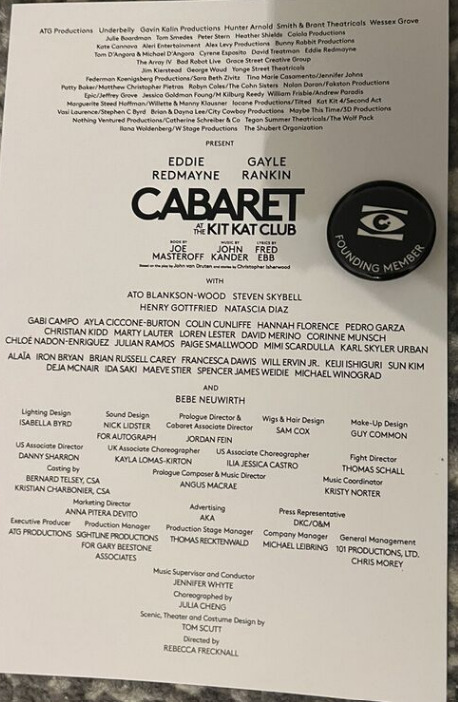
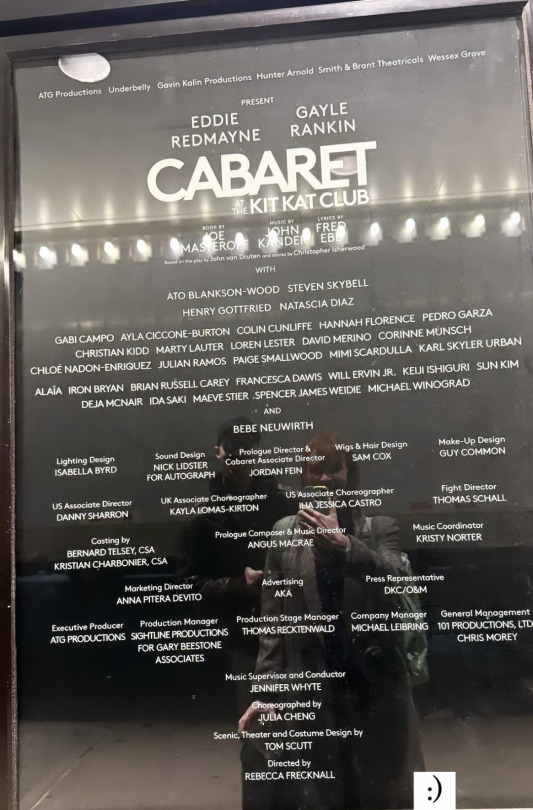
Left: first preview Playbill insert. Right: billing poster outside the theater.
Once more deviating from past productions, the roles of Cliff (Ato Blankson-Wood), Ernst (Henry Gottfried), and Kost (Natascia Diaz) are plucked back out of the company to be given featured billing. This time, Steven Skybell (Schultz) is on even footing with Cliff, even slightly under with his right-side billing. This would be the least "elevated" billing any Schultz has ever gotten. Skybell is a respected theatre veteran but not quite a household name, even in theatre circles. Blankson-Wood, meanwhile, is a recent Tony nominee. It's all politics when it comes to billing.
Here, Bebe Neuwirth (Schneider) is given the coveted "and" poster billing, no surprise. Of the featured roles, she's inarguably the biggest name. A few decades ago, that might have been enough to get her above the title, but these days it's less common that a solidly featured role would get that (unless you're Patti LuPone in Company, and Bebe doesn't have quite the same sway or ego).
This, to me, seems like the most obvious case of industry politics and agent negotiation at play, and usually actors (and egos) aren't even involved in the conversation. Skybell and Neuwirth aren't on the same level, though their characters are. My guess here is that producers want to bill their sole two-time Tony winner separately, and Skybell's agents know he isn't big enough to dispute that.

Now, let's take a look at this marketing design. Redmayne's name is left-billed despite being above Rankin's head. While annoying for those of us audience members who might just see this as a design flaw, this is all contractual, negotiated to death. Redmayne also gets front-and-center positioning, while Rankin is in the background, off-center, but she gets left-side position, which isn't as minimizing as right-side would. Left-billing is given to the bigger name because English reads left to right. These are the kinds of things I think about when I see marketing ads and playbills.
#cabaret#cabaret broadway#history lessons with doa#ask me about the sweeney todd teaser key art please it's an even better example of contracts at play#yeah i *did* stalk the ebay pages until someone put a playbill picture up for listing i'm just that dedicated to the craft#bebe neuwirth#joel grey#alan cumming#it's 9:30 a.m. but we're going live with this because why the fuck not?
24 notes
·
View notes
Text
this is the seinfeld episode where elaine is dating a guy with the name joel rifkin. you know like the serial killer. she isn't dating the serial killer (that would happen in a seinfeld episode though wouldn't it) he just has the same name. forgot this episode aired roughly a year before oj simpson's murder trial and elaine was trying to convince joel to change his name to oj
5 notes
·
View notes
Text
Gary Indiana, writing for New York Magazine in 2004:
A differently eclectic crowd of theater people converged most nights on Phebe’s at Bowery and 4th, wired from performing at La MaMa or Theater for the New City. I met Cookie Mueller in Phebe’s, and fell in love with her on the spot. Cookie had featured in John Waters’s early films. She acted, designed clothes, and also wrote stories and a medical-advice column, “Ask Dr. Mueller.” In a strictly hedonistic way, Eileen’s Reno Bar was integral to the East Village community. A narrow pocket of surrealism on Second Avenue between 11th and 12th, its ceiling surfaced in plastic jade plant—brown plastic jade plant—Eileen’s had its flaccid nights of dead-room tone. But most evenings brought a steady influx of pre-op transsexuals, clueless walk-ins, bisexual drug dealers, garrulous drunks with a schizophrenic flair, Ricardo Montalban types from Europe lusting after chicks with dicks, and a few black-humored fags like myself, who much preferred the Reno Bar’s nightly Halloween party to clocking the aging process in some drippy gay bar. Eileen’s had the carnal whoop-de-do of a fetish convention. It was also full of crack whores working the track on 11th Street. I once took a bar stool beside an enormous black woman I mistook for a drugstore cashier who’d rung up my toothpaste purchase that afternoon, which led to a dyslexic exchange of misunderstandings; I realized my mistake when she leaned close and declared in a tragic whisper: “You know something? My clitoris is as big as a penis. You know what I’m saying? My clitoris is the same size as a penis. I’m talking about a big penis. Can you understand what that makes me feel like?” One Eileen’s habitué named Joel wore a walrusy mustache and the woebegone, sagging face of the chronically defeated. His spot was the last bar stool in back, where a hideous painting, widely assumed to portray the Reno Bar’s ancient founder, hovered behind Joel’s thinning hair. (There was, and still is, an actual Eileen: I saw her a few weeks ago on the Third Avenue uptown bus. Older, but ever a star.) My friend Louie Laurita and I felt sad for Joel. Laconic and melancholy as he bolted down five or six G&Ts, Joel would haul himself out to his pickup truck and we’d see it hopelessly circling around at five miles an hour, until Joel returned, slumped and abashed-looking, to drown his abjection in more gin. “Poor Joel,” Louie habitually said. “Can’t even get laid by a whore.” Around the time when the Barnes & Noble megastore opened on Astor Place, we learned Joel’s last name was Rifkin. Over the years, he had strangled seventeen prostitutes in that truck. Here we’d been trying to cheer the guy up, and he’d actually been having the time of his life.
0 notes
Text
In "Well, That Aged Well"....
In the Seinfeld episode "The Masseuse," Elaine is dating a very nice man who happens to share names with Joel Rifkin the serial killer. She encourages him to change his name, picking several possibilities from the sports pages. The scene ends with O.J. Simpson.
And then....


Life: what a kidder.
0 notes
Text
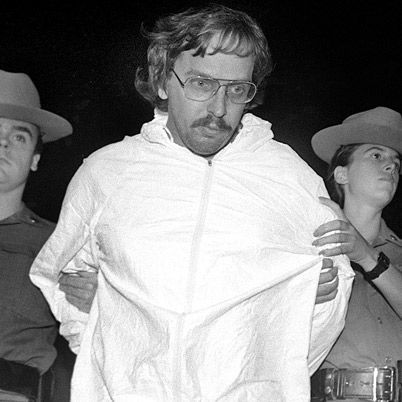
Joel Rifkin
Joel Rifkin is a serial killer who went on a string of murders in New York in the 1990s. In 1989, he killed his first woman. He discarded the bodies of his victims so they could not be identified. His reign of terror came to an end in June 1993, when Rifkin was pulled over by the police who discovered a corpse in his car. He was convicted of murder the following year and later pleaded guilty to additional counts of murders.
1 note
·
View note
Video
youtube
HISTORIAS de TERROR del la INTERNET
¿Qué se esconde tras la apariencia de un simple jardinero? ¿Qué secretos oculta su camioneta Mazda? ¿Qué horrores cometió en su casa de Long Island? En este video te contamos la escalofriante historia de Joel Rifkin, el destripador de Nueva York, que fue capturado con un cadáver en su vehículo gracias a una infracción de tráfico. Prepárate para conocer los detalles más macabros de sus crímenes, sus víctimas y su juicio. No te pierdas este episodio de Asesinos Seriales con Bing.
1 note
·
View note
Text
I don't wanna be edgy underage teen who worships for serial killers
#tcc#tccblr#tcc tumblr#dennis nilsen#joel rifkin#jeff dahmer#john wayne#gacy#richard rameriz#myra hindley#ian brady#aileen wu#salvador ramos#brenda ann spencer#dylan columbine#andrei chikatilo#viktor sayenko#igor suprunyuk#dennis rader#btk killer#adam lanza#karla homolka#pogo the clown#tj lane#pekka eric auvinen#eric columbine#mass murder
50 notes
·
View notes
Link
❝A woman that hates me this much comes along once in a lifetime.❞
Lisa Edelstein is back for her second episode as Karen. Jennifer Coolidge also guest stars. This is her first IMDb credit.
All the storylines are good, but none really take off.
8/10

0 notes
Text
The Madonna/Magdalene Ideology in how society view victims of serial murder in America


The iconography of Mary and Magdalene, stereotypically depicted as the "madonna/magdalene by Italian Renaissance artists, Fra Filippo Lippi and Carlo Crivelli. Most men and women have dualistic view toward women, then and now. Today, we use the terms good women and bad women. Or, to be precise, good mother/girl next door and loose woman/party girl
In the 1990s media depiction of serial murder victims, the media used photos of serial murder victims. The media used such photos either to elicit sympathy and compassion or that of sensation, shock, and scornful judgment. The Madonna/whore complex is used in such depictions of women, victim or not.


Miss Betty Jean Baucom, beautiful young lady victim of serial killer Henry Louis Wallace. Her graduation photo is used to evoke sympathy and compassion. She's depicted in blue, the traditional color of the Madonna.
Miss Jenny Soto, very beautiful Black Latina victim of serial killer Joel Rifkin. Mainstream media relentlessly used her picture to disparage her reputation. Margarita Gonzalez, Jenny Soto’s mother, was angry with the media’s depiction of her daughter and complained about the sensational headline in the media after Joel's confession in June 1993.
American society have a Madonna/whore ideology when it comes to women. From historic times, societies in general always label women as either good, chaste women, wives, mothers, nuns or they're loose women, prostitutes, and mistresses/courtesans. Renaissance artists reflected societal views of women through the Madonna paintings by famous artists Lippi, Botticelli, Raphael, etc., or nude paintings such as the Venus of Urbino by Titian. In American society, the Madonna/whore ideology is strong, tinged with class and race components. White and other non black women, especially East Asian women are considered the "sacred Madonna" while Black, Native American, and Latinas, especially Caribbean Latinas are labeled as "bad women" deserving of their fate. This view is far more widespread as the lack of coverage, the disparaging remarks in and out of cyberspace, and general indifference on the part of law enforcement to solve murders of Black women in America and Indigenous women in Canada. The Madonna/whore mythology were used in how the public reacted to murders of Black women, the Heidnik, the Larry Bright, Gary Ridgeway, the Sowell case and the Henry Louis Wallace cases in particular. For example, the Cleveland convenience store owner showed sympathy to Anthony Sowell, whom he said in the Unseen interview that "he took out the garbage". That's a blatantly hateful remark. He saw the victims, living and dead, of Anthony Sowell as being "worthless" and "undeserving" to him. He labelled the victims as worthless drug addicted and prostitutes. Sowell himself justified the murders by labelling the women as being less than perfect. Again using the Madonna/whore ideology was at work in connection to the inaction on the part of Charlotte police in connection with the Henry Louis Wallace serial murder case, a concerned young woman named Angala Grooms in East Charlotte stated that the police did not care because they viewed the pretty young Black female murder victims of Henry Louis Wallace: "I feel like they wrote us all off as some fast little black girls who didn't really matter." During the 1996 Wallace capital murder trial, the defense lawyers tried to taint the young womens' reputation but the witnesses, friends, family, co-workers, colleagues, and the prosecutor vigorously countered the defense by bolstering the virtues and even saintliness of the young victims of Wallace. The jury didn't buy the defense and voted for the death penalty for the nine first-degree murders and rapes of young Black women.
#madonna#madonna-whore#misogyny#serial murder#anthony sowell#joel rifkin#henry louis wallace#Jenny Soto#Betty Jean Baucom#Gary Ridgeway#mary magdalene
9 notes
·
View notes
Text
Serial Killers who were active in the same place.
Los Angeles, U.S.A
The 1980s were a dangerous time in Los Angeles. There were three serial killers on the loose, all preying on women. Michael Hughes, Lonnie Franklin Jr. (also known as The Grim Sleeper), and Chester Turner all committed their murders primarily in the 1980s, although the Grim Sleeper took a break and went back to killing in the 2000s.

Hughes sexually assaulted his seven victims before strangling them to death and dumping them in various areas around the city. He was caught in 1993 and is currently on death row. Franklin was apprehended in 2010, and was sentenced to death for the murders of 11 victims, all women who were raped, shot, and then dumped in back alleys. Turner also killed 11 women by strangling them to death. He was caught in 2003, and is on death row alongside Hughes and Franklin.
LONG ISLAND
In the early 1990s, people living on Long Island had the right be scared. There were three serial killers active during the period - Joel Rifkin, who murdered at least 16 women between 1989 and 1993; Robert Schulman, a former postal worker who killed five sex workers in a five-year span starting in 1991; and Colin Ferguson, who killed six people on a commuter train in 1993.
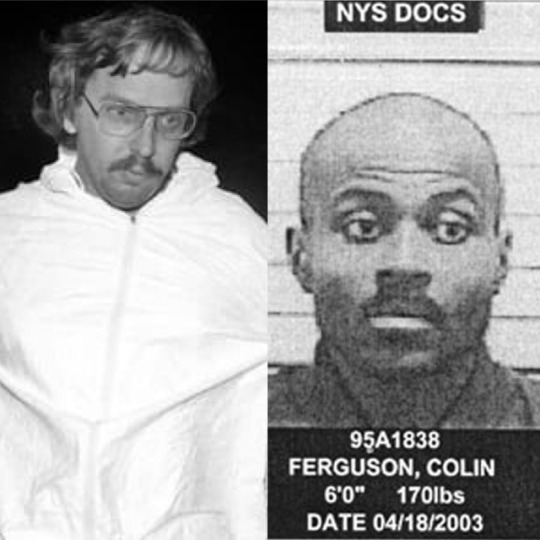
Rifkin picked his victims up on Long Island and in the city - similar to Schulman - and is suspected to also be the Gilgo Beach Killer. Schulman was caught after a person saw him dumping a body from his brother's Cadillac. Ferguson shot and killed six people on a commuter train, injuring 19 others.
Rifkin was sentenced to 203 years in prison back in 1994, Schulman received a death sentence in 1999, and Ferguson was sentenced to 315 years in prison. Schulman died in 2006 of undisclosed causes, and Rifkin will be up for parole in 2197. Interestingly, Rifkin and Ferguson were housed at the same prison—Attica Correctional Facility. The two got in an argument over the telephone and they allegedly bragged to each other about how many people they had killed.
New York City, USA 🌃
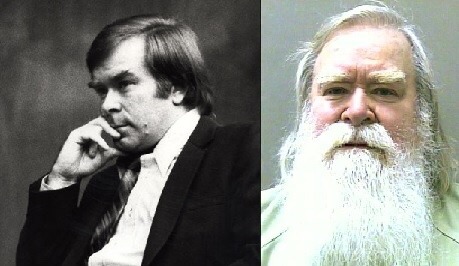
New York City is known for its cultural institutions, interesting history, and, of course, its serial killers. Richard Cottingham and David Berkowitz, both were active in the city back in the 1970s. Cottingham, also known as the Torso Killer, has six confirmed victims - all women - but he claims to have killed between 85 and 100. He mutilated the bodies of his victims, often leaving just a torso behind.

Berkowitz, aka the Son of Sam, shot 14 women with a .44 caliber gun during his murderous spree, killing six and wounding eight. Cottingham is currently serving the first of several life sentences, while Berkowitz is up for parole every two years, but each time, he tells the parole board he shouldn't be released. Berkowitz became devoutly religious in prison and has taken responsibility for his crimes, saying “In all honesty I believe that I deserve to be in prison for the rest of my life.”
SANTA CRUZ, CA, U.S.A
In the early 1970s, Santa Cruz, CA, had not one, not two, but three serial killers lurking about. One was Edmund Kemper, a Department of Transportation employee who had been diagnosed with paranoid schizophrenia as a youth. He killed at least six women, all of whom were hitchhikers that he picked up at the side of the road, as well as his mother and one of his female friends. He was caught in 1973, and has been incarcerated in the California Medical Facility in Vacaville, CA, ever since.

While Kemper was killing young women, Herbert Mullin was on a killing spree of his own, believing that each death helped him prevent earthquakes. In all, he committed 13 murders. His victims ranged in age from four to 72, and were mostly men. Mullin was caught in 1973. He pled guilty, and received a sentence of life in prison. He is currently at Mule Creek State Prison, where he will be up for parole in 2021.
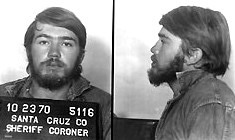
And to round out the Santa Cruz killers was John Linley Frazier who, in 1970, killed five people. Frazier attacked and killed ophthalmologist Victor Ohta, his wife, their two sons, and his secretary after spiraling into a rampage. Frazier said he was an agent of God. He was arrested and sentenced to death in 1970. In 2009, he hung himself in his prison cell.
Wisconsin, USA.
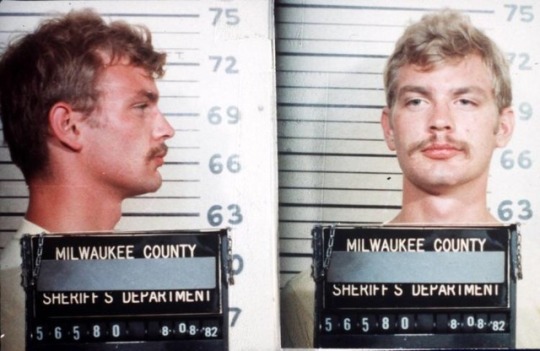
When most people think of serial killers in Milwaukee, Jeffrey Dahmer is the first person to come to mind. Dahmer is best known for his cannibalisation of his victims, all of whom were male. He killed at least 17 between the years of 1978 and 1991. While that was going on, Walter E. Ellis, another Milwaukee resident - murdered seven women over a 21 year span - 1986 to 2007.
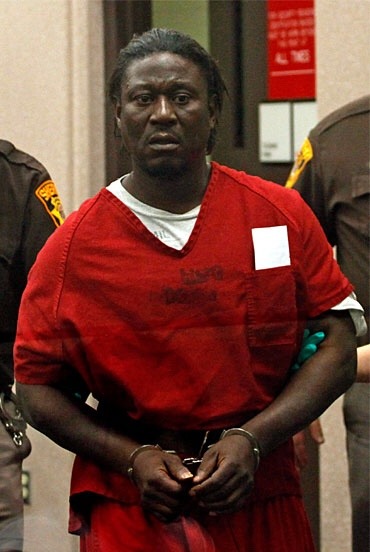
Ellis raped and strangled his victims, and was caught in 2009 thanks to a series of DNA matches. He died in South Dakota in 2013 while serving out the life sentences that were handed to him. Dahmer died in prison in 1994 at the hands of a fellow inmate.
#true crime community#tcc#true crime#murder#crime#criminal#murderer#reblog#follow#killer#serial killers#herbert mullin#edmund kemper#ed kemper#john linley frazier#john frazier#michael hughes#lonnie franklin jr#chester turner#joel rifkin#robert schulman#colin ferguson#jeffery dahmer#jeff dahmer#walter e ellis#richard cottingham#david berkowitz#son of sam#victims#victimology
509 notes
·
View notes
Text
Episode 30 is available now wherever you stream podcasts.
This is part one of Joel Rifkin aka Joel the Ripper.

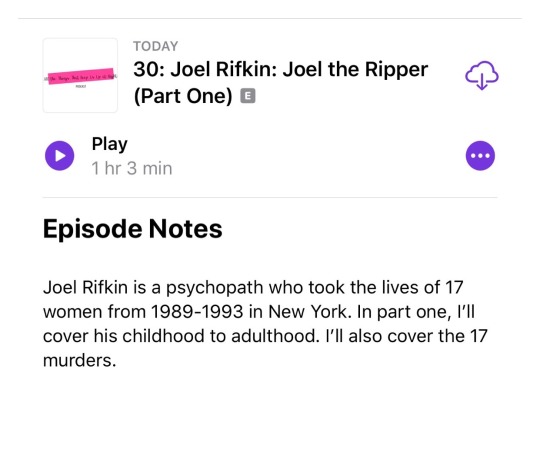

#truecrime#truecrimes#true crimes#true crime#trials#true crime community#true story#truecrimeaddict#true crime podcast#truecrimepodcast#truecrimejunkie#truecrimecommunity#crimes#crime news#crimepodcast#crime podcasts#crimenews#joel rifkin#joelrifkin#longisland#long island#newyork#new york#spotify#podcast#podcasts#podcasting
0 notes
Photo

“Goofy nobody who wanted to be a somebody, admits killing 17 women.”
2 notes
·
View notes
Text
I was watching a show called Dark Minds and ran across this case i had never heard of before. It really creeped me out, certain details...
Michigan, Feb 1976- March '77-
Someone was killing children. Within a 13 month period, at least 4 children were taken. Whoever this was, he was taking both male and female kids, 2 of each. And he was holding them captive somewhere for a good deal of time, sometimes weeks. When he was done with the kids, he took great care in perparing their bodies before dumping them. The killer would bathe them, wash and even iron their clothes, and dress them back up in the clothing they went missing in. Their remains were carefully placed in a spot where they'd be found almost immediately- like a shopping center parking lot or a neighborhood. They were found with their eyes closed with their arms crossed over their chest.
3 out of 4 of the children had been suffocated to death; the other, a little girl, was shot in the face at very close range. The shooting was very out of character, something must've gone wrong for him to use a gun.
The 2 boys had been bound and sexually assaulted multiple times, they were found with ligature marks on their arms. The girls were not believed to have been molested. Which is curious, why take girls at all?
12 y/o Mark Stebbins was the first known victim. He was playing pool with his brother when he decided he was ready to go home. Mark walked out of the American Legion Hall in broad daylight on a Sunday; no one who loved him would ever see him alive again. His body was found 4 days later, he was super clean, arms folded over his chest, eyes closed, and wearing the hoodie he was last seen in.
The second victim was 12 y/o Jill Robinson, she went missing just days before Christmas, December 22nd. On the day after Christmas her corpse was discovered. Jill was the one who was shot, and she was wearing her backpack, just as she had been when she went missing.
The 3rd victim was 10 y/o kristine Mihelich. She went missing just a week after the 2nd, and was kept captive for 19 days. The 4th and final known victim is 11 y/o Timothy King, he went missing while out riding his skateboard on March 16th. His father was a wreck that his son was missing and he printed a letter in the paper saying when Tim came home he was planning to feed him his favorite meal, KFC. During autopsy they discovered that is exactly what his last meal was. Kentucky Fried Chicken.
There are 2 other victims, one who survived, which are commonly contributed to this killer. But they know without a doubt that these 4 are for sure connected.
There are quite a few suspects, more than one pedophile has been taken off the street due to this investigaton. It's known the killer had a place to keep these kids for such long periods of time, and they were looking for more than just one person- no less than 2.
The suspect who makes the most sense was a wealthy man named Chris Busch. Chris was a man who'd recently been convicted of molesting dozens and dozens of kids. His father was a rich GM exec with plenty of clout, which is the likely reason why his pedo partners were sent to prison, Chrisnever spent a day incarcerated. He took a polygraph test and it was said he passed. He was released. Recently other experts have looked at the results and they all disagree- Chris flat out failed the lie detector test. Soon afterwords, Chris "Committed Suicide".
Now this suicide appears to be anything but! He supposedly shot himself between the eyes with a shot gun. Already sounds off, doesn't it? There was absolutely no gun powder on Chris, and more spent bullet cases were found in the room, but the actual bullets were gone.
There was also bloody ropes in his room, the kind that could've been used to tie the kids up while they were sexually assaulted. And there was a drawing hanging on the wall, did you see this drawing? It's of a boy wearing a hoodie, and he's screaming. It's terrible to look at. It's believed this is a drawing of the first victim being assaulted- being tortured. Mark's brother absolutely believes the drawing is him. Many believe that Chris's accomplice murdered him and staged the scene, leaving the bloody ligatures and the drawing of Mark to point the finger at Chris.
Recently the evidence has been looked at again, and hairs were found on the clothing. The hair didn't match Chris, but they did match a teenaged male friend of his. And that would make the most sense: a 14 or 15 year old boy would've met the victims and convinced them to go with him and Chris, ultimately leading them to their death. It would explain how it was so easy to get these kids to go with them in broad daylight. But you can't convict a person on hair alone. And those ropes found at the scene of Chris's suicide, those ligatures that likely could've solved this case? Gone- just missing out of evidence.
The murders stopped right after Chris died, but the families still have very little peace. Hopefully someday this one will be solved, the young accomplice needs to be brought to justice. There are some other theories, including Wiccan sacrifices (sounds like BS to me, i don't know of ANY wiccan who would do that- they believe you get back what you put out.)
I'm gonna add a link or two in the comments. One is of the victim's father's site. Tons of extra info if you're interested.
**PS- Have you seen this show, Dark Minds? It's on ID, I believe, but if you don't have access too cable it's also on YouTube. I'm not a huge fan of the host, but they do consult with well known serial killers which makes it watch worthy. "Raven" is really SK Keith Jesperson and it's believed that 13 is Joel Rifkin.
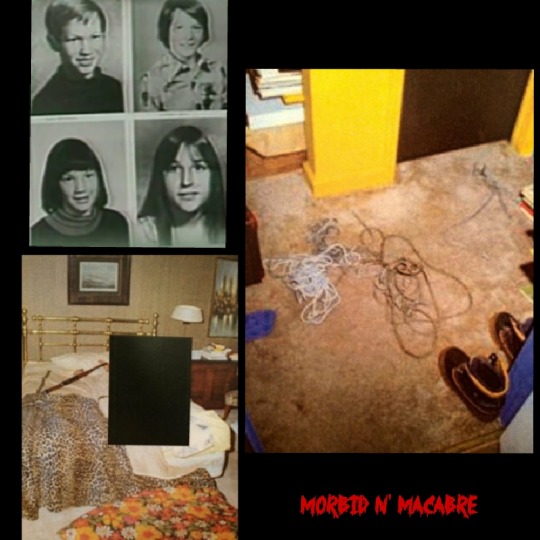
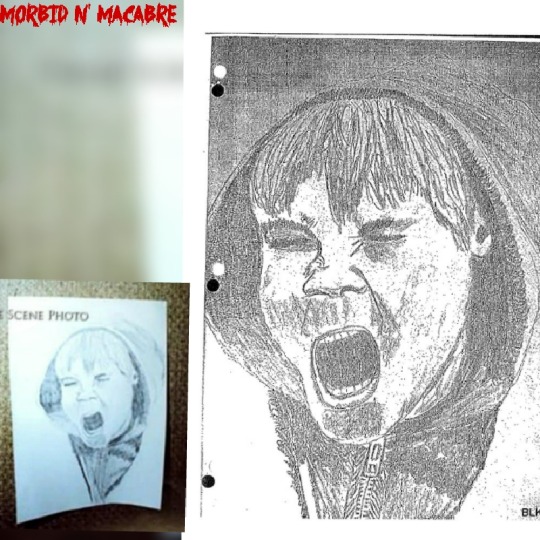
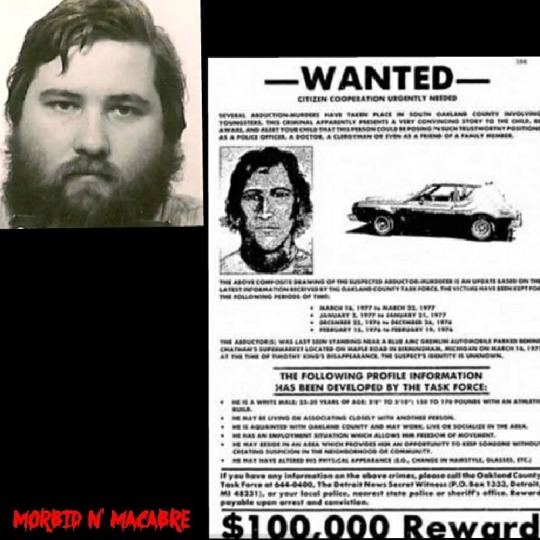
#true story#true crime community#true crime#murder#serial#serial killer#unsolved mystery#unsolved#cold case#id#investigation discovery#joel rifkin
7 notes
·
View notes
